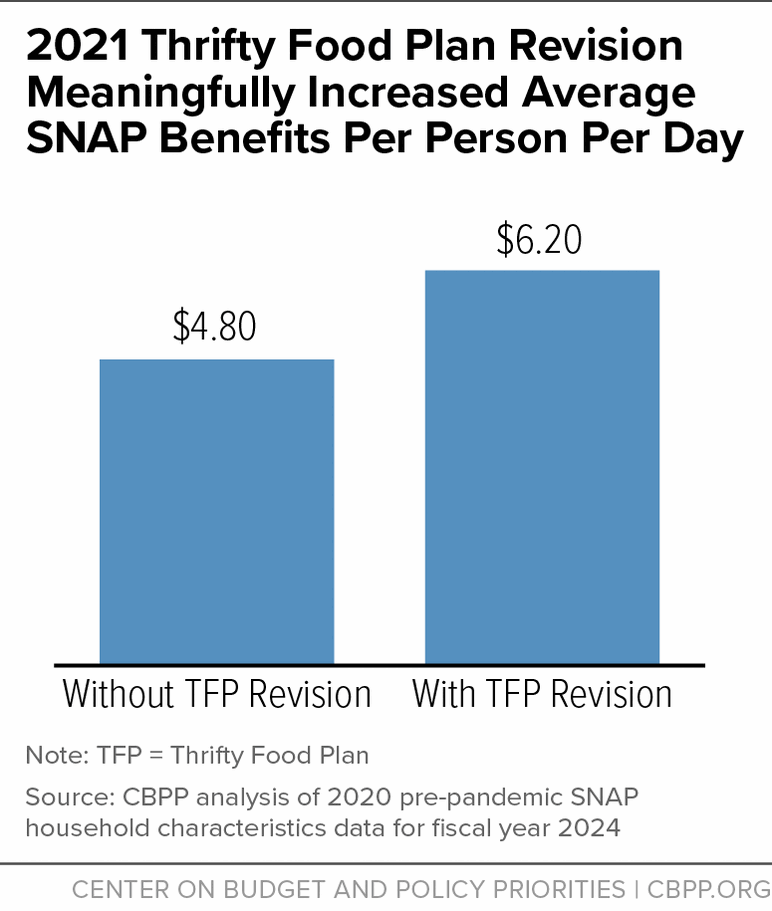BEYOND THE NUMBERS
House Agriculture Committee Chairman Proposes Cut in SNAP Benefits, Reversing Bipartisan Directive to Improve the Thrifty Food Plan
At a House Agriculture Committee hearing on February 14, Chairman Glenn “GT” Thompson (R-PA) proposed a funding framework for the farm bill that included a $30 billion cut in SNAP benefits over ten years. Congress should reject Chairman Thompson’s proposal.
The chairman’s proposal would limit USDA’s future adjustments to the cost of the Thrifty Food Plan (TFP), which is used to set SNAP benefits, to account only for food price inflation. The TFP is a set of foods that is supposed to represent a frugal but nutritionally adequate diet. A bipartisan directive in the most recent farm bill, enacted in 2018, requires USDA to periodically reevaluate the TFP to account for factors other than food price inflation, including changes in dietary guidance and food consumption patterns. This directive led USDA to make a substantial TFP adjustment in 2021, making up for five decades of deferred adjustments, through a science-driven process.
At the hearing, Chairman Thompson suggested that the savings from his proposal to limit future TFP updates would be used to fund other priorities within the nutrition title as well as in other parts of the farm bill. He also asserted that the proposal would not be a cut because average benefits would still rise each year with food price inflation. However, over time, the scientific evidence on healthy diets evolves and costs may go up for reasons other than inflation. If Congress limits future updates to cover inflation only, that’s a benefit cut, as reflected in the nonpartisan Congressional Budget Office cost estimate.
The chairman’s proposal is unwise for several reasons:
- The long-overdue 2021 TFP adjustment helped put a healthy diet within reach. Prior to the reevaluation, millions of people could not afford a healthy diet because SNAP benefits had long been too low. Letting the TFP’s cost rise only with inflation for decades resulted in absurd and unrealistic assumptions — for example, that in order to meet the dietary guidance at a very low cost, families would buy 25 pounds of milk and 20 pounds of orange juice each week. Dietary guidance in the 1970s, when the TFP was first established, specified minimum amounts from four food groups: milk, meat, fruits and vegetables, and grains. Scientific evidence has since emerged about the importance of certain nutrients and foods, such as dark green vegetables, red-orange vegetables, whole grains, and seafood. The 2021 TFP adjustment addressed these developments, and USDA should not be banned from making sensible changes like this in the future.
- TFP adjustments can also address the time constraints faced by working families. Preparing healthy meals requires both money and time. With the increase in women’s labor force participation since the 1970s, many families lack time for food preparation. Grocery stores increasingly offer time-saving forms of food to help put a healthy meal on the table, such as pre-cut vegetables and ready-to-cook cuts of lean meat. By contrast, prior to the recent update, the TFP assumed that households spent many hours each week hand-preparing meals—for example, rinsing, soaking, and cooking dried beans for hours rather than using canned beans. By incorporating time-saving healthy options, the 2021 TFP is more realistic and better aligned with the foods that people currently buy and the time people have to purchase and prepare food.

- Limiting future reevaluations of the TFP would ignore scientific evidence and lead to SNAP benefits becoming out of step with a healthy, achievable diet. Future updates likely won’t be as big as in 2021 because they won’t have to make up for 50 years of changes in dietary guidance and other factors. But they could still be meaningful, as nutrition science continues to evolve and food options change to reflect the time constraints families face.
SNAP benefits remain modest even after a TFP adjustment. The 2021 increase was meaningful but modest, raising the average SNAP benefit from about $4.80 to about $6.20 per person per day. (See figure.)
This modest adjustment is nevertheless making a real difference for families at risk of running out of food before the end of the month. It’s also helping families better meet today’s nutritional standards within more realistic time constraints for meal preparation.
- Children need SNAP benefits to stay up to date. The 2021 TFP increase lifts over 2 million SNAP participants — including over 1 million children — above the poverty line and improves food security and promotes children’s health. SNAP also helps children succeed in school. If SNAP is allowed to fall out of step with the cost of a healthy diet, these positive effects could be diminished.
SNAP is our nation’s most effective tool for combating hunger and food insecurity. We shouldn’t go backwards and allow SNAP benefits to become increasingly out of step with the cost of a healthy diet.
